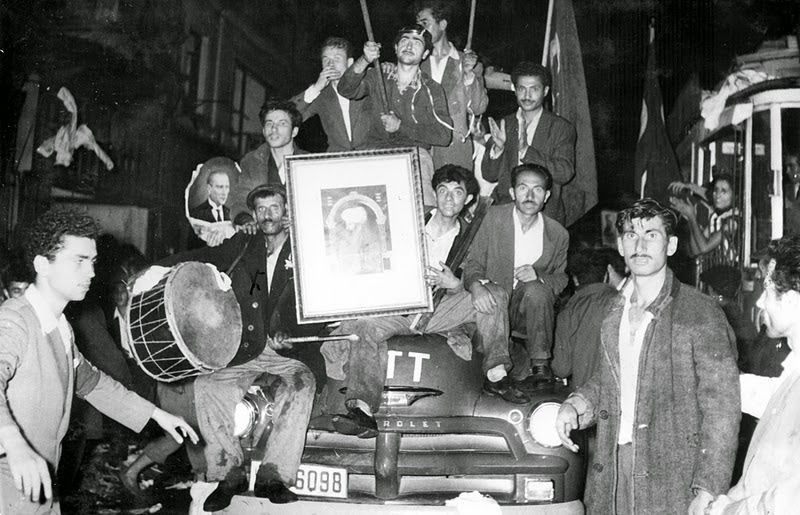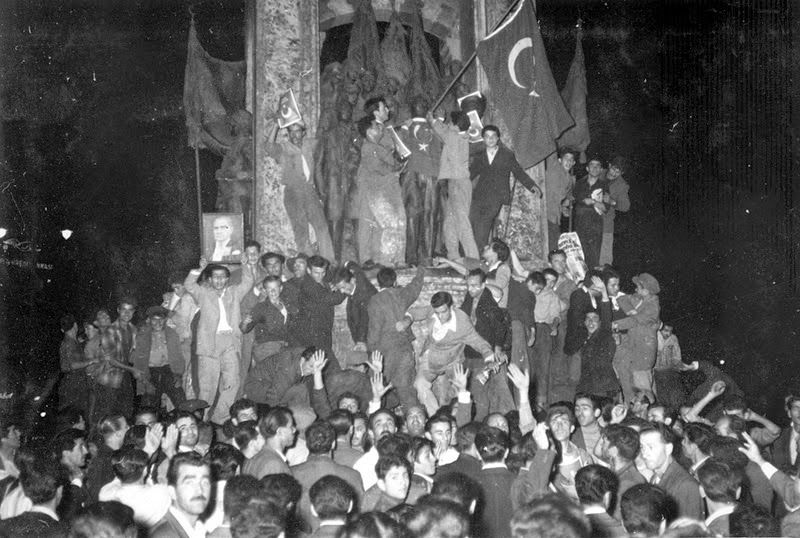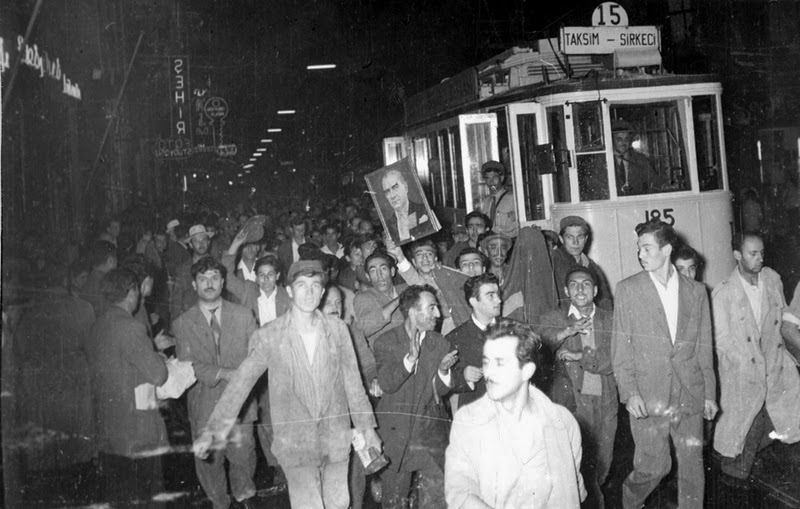We all know that the change of the name from Constantinople to Istanbul in 1930 was significant. Ataturk was showing the West that the newly founded Turkish Republic was different than Ottoman Empire as day and night, while he was trying to arrest his people attention to the fact that it was time to embrace a sense of nationalism in order to build this new Turkish nation-state.
The Istanbul Pogrom of 1955, also known as the Istanbul riots or the September events, was not an unexpected event that came out of nowhere. It is also a mistake to believe in any correlation between the Cyprus issue and the Istanbul Pogrom. If we are going to talk in depth about this topic, we should first mention the Turkification movement which was developed by a group of Ottoman intellectuals who are known as the “Young Turks” and then solidified by Kemalist elites. We need to address these facts if we want to understand truly how Constantinople-Istanbul came to end.
The Young Turks believed that the Ottoman multicultural spirit was outdated and was about to collapse. The solution to them was forming a nation-state by homogenising all economic, political, and ethnic aspects of Turkish society. They pushed the Turkification movement forward because it allowed them to embark on a campaign of ethnic cleaning of minorities. Its implementation started with the Armenian incidents in Anatolia. The population exchanges and Varlık Vergisi (Wealth tax) followed. Right on time the Istanbul Pogrom came about as the fatal blow aimed to create a state of only one colour, one race, one religion, one language. All these policies found justification under the saying of Atatürk, “How happy is the one who says ‘I am Turkish’ (Ne mutlu Türküm diyene).”, which used regularly by the Kemalist elites and clearly illustrates the ideology of Turkification which summarizes the state’s policies toward non-Turk groups.
All the environmental conditions necessary for expelling the last of the remaining minorities from the country were in place by the 1950s. Turkey and Greece had been allies of the United States after the end of World War II. Since Turkey and Greece had joined the same gang, they needed to develop their relationship. To appease big brother U.S.A, Turkey and Greece made a pretty great effort to get along but it didn’t work out. The Greek politician Venizelos published the aspirations that Greece had for Cyprus and the Turks did not reply to this kindly. In the island, the Greek-Cypriot EOKA (an underground nationalist movement) increased tensions as well. Turkish-Cypriots formed an organization to defend themselves against EOKA. Then the fighting began between the two sides. Greece and Turkey made attempts to at least try and find a solution however they couldn’t stop the blood from spilling.
Britain took responsibility and led a conference in London. The aim of the conference was to find a solution to end the fight. However, during the conference the Turks gave into an old habit, decided to play a trick; a pogrom against the Greeks to show the world how Turks felt about Cyprus. Thus, they hoped to gain some sort of advantage over the Greeks during the conference. That is what they thought would happen. What actually happened? They couldn’t control the trick that they were playing and the trick turned into a shameful story.
During the evening of September 5th, Istanbul received the news that Ataturk’s birthplace in Thessaloniki had been targeted in a bomb attack. Indeed, agents from the Turkish Special Warfare Department had thrown a bomb into the house, and blamed this act on the Greeks. Under such intense political tension, what could be a more perfect rallying cry? The news that Greeks had attacked Ataturk’s sacrosanct birthplace was announced by the state radio in the afternoon. Immediately afterwards, the Istanbul Ekspres newspaper printed the breaking news as well. There were 300,000 copies printed. Previously, this newspaper had never produced more than 20-30 thousand copies at once. As expected, all the copies were sold in a very short time.
Naturally people took to the streets to voice their displeasure. Taksim welcomed university students at first. The students were predictable. They protested on their own and left after it got dark. Then, angry mobs who were brought from other cities replaced the students. Some of these people came well-equipped and had lists of names and addresses of Greeks in their hands. The state sponsored assault began with the smashing and looting of Greek shops. This was followed by mobs entering houses by force, assaulting non- Muslim people, and throwing their belongings out into the streets. Unable to stop or calm down, they attacked churches, set some of them fire, harassed the priests, and damaged the holy icons and relics. It may sound exaggerated or ridiculous, but even Greek cemeteries were being desecrated during the riots.
The police remained passive. Closing their eyes and ignoring the marauders was much easier for them. One story I have read said that that the rioters went to the Prince’s Islands in small boats. They talked with the security at the harbour and then began to pirate the islands. They returned back to city without any problem. There are several other unique stories, when after hearing them you’re not sure whether to laugh or cry. During the protests a clever Jewish shopkeeper close to Tünel swapped his Turkish neighbour’s signboard with his own. In the end the Turkish store was looted because the angry crowds thought that the store belonged to a Jew, while the real store received no damage. Another story tells about a desperate Turkish shopkeeper who pulled down his pants to show his circumcision in order to prove that he was Muslim and Turkish.
The riots didn’t end until after the Turkish army arrived in Beyoğlu the next morning. By then, around 15 innocent people were already dead, more than a hundred women had been raped, and almost 70 churches, 20 schools, 4000 Greek-owned businesses, 4000 homes and a few cemeteries had been looted or vandalised. Elsewhere in the city, the crazed crowd had even unabashedly set fire to 52 different quarters such as Arnavutköy, Ortaköy, Karaköy, Eminönü, Sirkeci, Gedikpaşa, Kumkapı and Bakırköy.
A day after the events ended, the Menderes government closed the “Cyprus is Turkish” Association. Its executives were arrested. The Minister of Internal Affairs resigned on the 10th of September. Two days later, the government blamed Turkish Communists for the incident. However, the Menderes government received heavy criticism for its part in the riots.
In the first two weeks following the pogrom, the Greek consulate received numerous request from Greeks of Istanbul to fly to Greece. However, both consulate and Patriarchate tried to stop this wave of migration. They were successful, there was no massive migration of Greeks from Istanbul after the events. On the other hand they were very disappointed by the stance of Turkish state. The only mistake the Greek minority made after the event was ever trusting Turkish state again. It was a big mistake because they were sent to Greece only a few years later. Sadly, Turkish society only recognised the real perpetrators behind the events after the trials in Yassıada.
After the coup d’état in May 1960 which was against the first democratically elected government of the Menderes’ Democrat Party, President Celal Bayar and Prime Minister Adnan Menderes were put on trial by a military court on the island of Yassıada. The junta who had a hand in the 6-7 of September events accused Adnan Menderes and Celal Bayar of violating the constitutionally guaranteed rights of the Greek-Orthodox minority as citizens and for provoking Turkish citizens into demonstration and violence. They were found guilty for many crimes including those which were related to the events of the 6-7 of September. Adnan Menderes was put to death on September 17th in 1961 on İmralı Island. The punishment for Celal Bayar was commuted to aggravated life imprisonment, but he was released in 1964 due to poor health.













Thank you for the great article !
I’m a secular turk, and truly appreciate ataturk’s reforms (i.e, ataturk inkilaplari) … as they served turkiye largely well … However, i, at the same time, think that Ataturk (and his henchmen) are, mostly, responsible for major political, social and economical issues troubling us more than ever ….
For one thing, Ataturk’s biggest mistake was the so-called population exchange (or Mubadale) with Greece in 1924 … Now, imagine if , today, in 2018, twenty (yes 25) percent of Turkiye was still ethnically Greek (or Rum) ….. and i can guarantee you that Turkiye, would have achieved the following:
1- No right-wing political parti/movemnts would have ever been to form a government in Turkiye …
2- Turkiye would have managed to join the EU long time ago, perhaps before even Greece and Portugal, or Spain …
3– We would have not have the so-called Kurdish question (or Kürt sorunu) as the Kurds would have been quite satisfied and happily living as equal citizens of a progressive EU-member Turkiye …
4– The Istanbul Pogrom– 1955, would not have happened ….
5- Turkiye, today, financially, militarily, industrially, economically and socially would have been a global power on the same scale as France and Japan …
By the way, i’m surprised to notice that people on Quora often pose mundane questions about Turkey & Greece history, and relations …. etc, But nobody ever ask as to how Turkiye and Greece would look like today economically, socially, politically, economically and militarily ??